The Samsung Galaxy S7 & S7 Edge Review, Part 1
by Joshua Ho on March 8, 2016 9:00 AM ESTDisplay
As always, the display of any mobile device is a critical part of the overall user experience. A poor display in any way is often going to sour the entire experience.
On a personal note, there are a number of mobile devices that I’ve used over the course of the previous year that frankly just weren’t good enough for me to use as a daily driver because the display just wasn’t good enough. My laptop is quite closely calibrated to sRGB and it’s used to edit all of my device photos, so I’ve really come to appreciate a device that has sufficiently accurate color that I can actually use a phone or tablet as a reference monitor of sorts to verify that images look the way I want them to.
In order to test this critical portion of the user experience, we turn to our standard test suite which uses SpectraCal’s CalMAN 5, a custom workflow for testing basic metrics like brightness, contrast, and calibration accuracy, and X-Rite’s i1Pro2 and i1DisplayPro.
Starting off with a microscope's view of the Galaxy S7's display, it looks like Samsung has elected to keep most aspects of the display constant when comparing the Galaxy S6 and S7. At a high level, the display is the same 5.1” display size that we’ve seen for a few generations now, and the 1440p resolution is shared with previous devices. Samsung continues to use their diamond PenTile layout, but it’s hard for me to say whether there’s been an adjustment to the size of the emitters as the microscope I have on hand isn’t quite sufficient for making such measurements. It’s likely that under the hood there are changes to the display driver IC in order to enable features like Always-On Display, but as we’ll soon see it’s rather unlikely that there are any generational changes in things like the emitter material or TFT backplane.
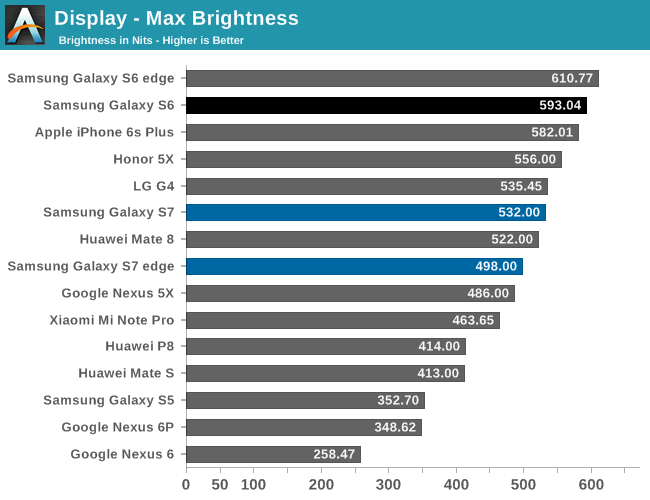
One of our first tests here is a pretty standard test of maximum luminance. Here, we see that the Galaxy S7 and S7 edge both are in the same general ballpark as the Galaxy Note5, which suggests that both devices are likely to be in the same generation of AMOLED panel. This brightness was achieved by using the auto-brightness mode, so it’s important to note that the max luminance in manual mode will be much lower. Of course, this brightness figure was determined with a full white display so reducing the APL will result in a higher maximum luminance as the power budget can we spent on fewer pixels which means that a higher duty cycle can be achieved in each pixel.
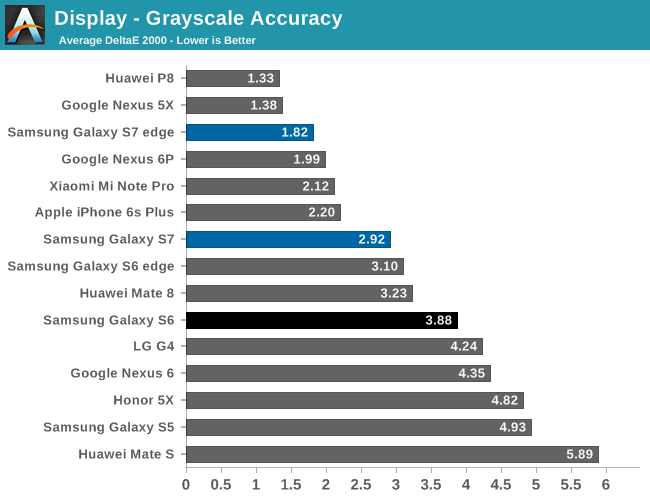
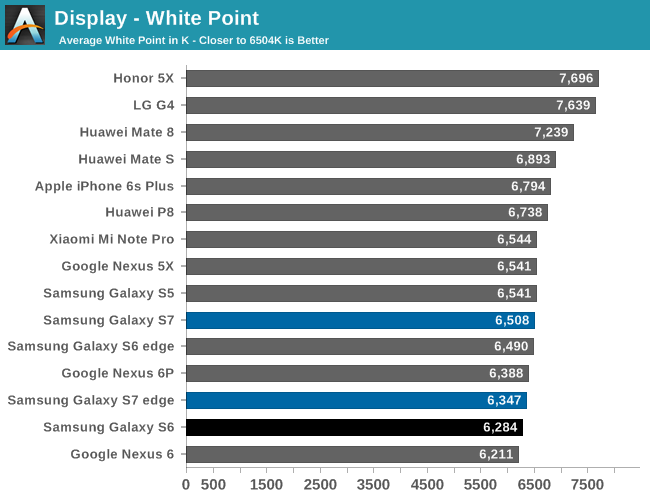
The next part of our testing is grayscale. As always, we target the industry standard of a 2.2 power gamma with 6504k white point. Relative to the Galaxy S6 and Note5, we see a pretty significant improvement in white point accuracy as it’s pretty much consistently quite close to a neutral white rather than a warmer color balance. Unfortunately though, in both review units I received the display has a noticeable green tint for many shades of grey, which seems to be somewhat of a perpetual problem with Samsung AMOLED displays. This really does affect quite a bit of the UI, as Material Design greys have this noticeable green tint to them that really makes things look off.
The same issue seems to not be present on the Galaxy S7 edge, which leads to a significant improvement overall in calibration quality for this portion of the testing, but both devices have a noticeably lower gamma than expected, which does have some effect on accuracy but for the most part can help to serve as a compensation mechanism for reflectance when dealing with ambient light. It’s likely that the green tint issue may only appear on a device to device basis, but to see that such issues haven’t been resolved for years is somewhat concerning given that phones costing hundreds of dollars less don’t seem to have the same problems.
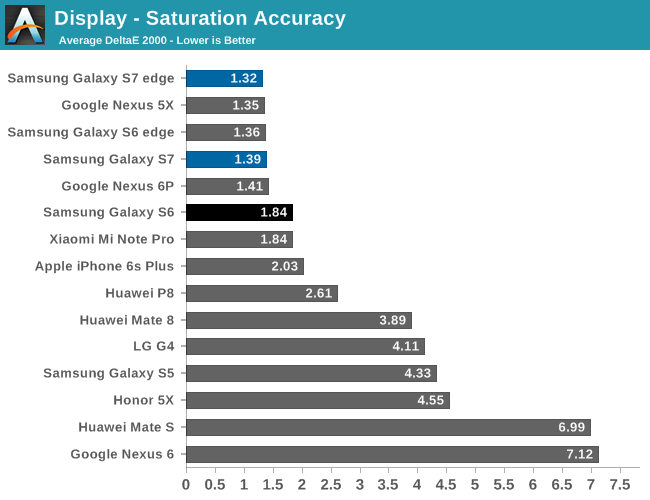
The next portion of our testing is the standard saturation sweep test. Here, the Galaxy S7 and S7 edge are basically perfect. It’s great to see that Samsung continues to provide their Basic color mode with a real focus on providing accurate color calibration for those that care about these things, and the user experience with getting to the right color calibration is pretty much as painless as it can be compared to some other devices where things like saturation curves, white balance, and other parts of a display calibration can only be adjusted using unitless sliders that basically require a spectrophotometer to actually use.

In our Gretag MacBeth ColorChecker test, we see that there are some issues with grayscale accuracy, but overall color accuracy remains quite good. In terms of overall display quality, I don’t really think there’s any meaningful improvement over the Galaxy S6, but that’s mostly because the Galaxy S6 set a ridiculously high bar for display quality.
However, I don’t believe that Samsung has run out of things to improve for future AMOLD displays. In addition to the grayscale problems mentioned earlier, Samsung clearly has not resolved issues with color shifting that occurs with viewing angle changes. LCDs definitely have more luminance degradation as you move away from the normal of the display plane, but at almost every angle change I can see whites get noticeably colder and interference patterns, in addition to a general color shift that is noticeably more than most LCDs used in high end smartphones and tablets. It’s obvious that this is a hard problem to solve due to uneven subpixel aging, but for things like tablets, laptops, and desktops color shifting is going to be a much more significant issue.


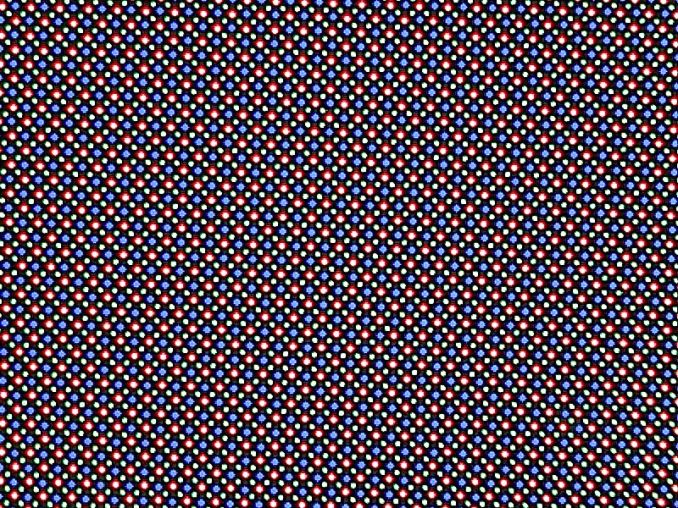

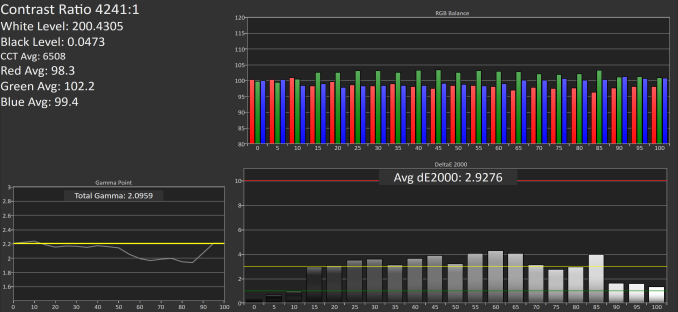


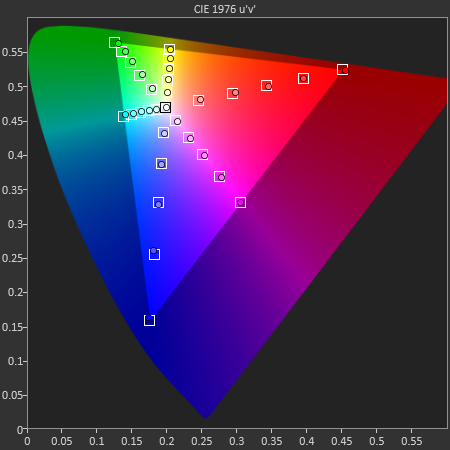
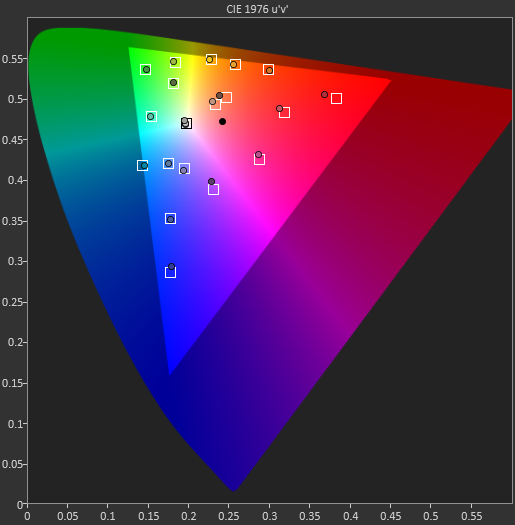
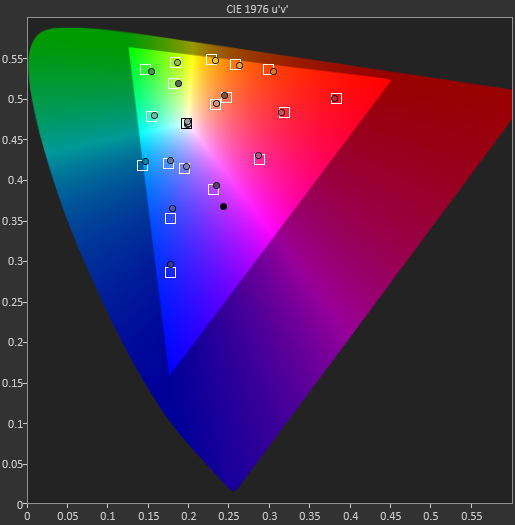








202 Comments
View All Comments
danbfree1 - Tuesday, March 8, 2016 - link
As a brand-agnostic consumer, I had gone with the LG 2/3 for my previous phones but recently picked up an S6 due to a deal I couldn't refuse... I'm impressed with how Samsung, beginning with the S6, significantly toned down the bloat of Touch Wiz and also got rid of the cartoonish oversatured colors of the screen. With the screen setting in Basic mode, colors are very accurate... It's only weakness is average battery life, which is silly because of how much the camera sticks out anyway, there was no reason to make it so thin. Even with a thin case that I prefer, it STILL sticks out...Also lack of expandable memory and waterproofing was sorely missed in the S6. With the S7 they addressed these issues and beefed up processing and RAM even more. Great job, Samsung! Now just make the battery removable next time! With the LG G5 coming out soon, it;s nice to see such good competition in the Android flagship market!Homerr - Tuesday, March 8, 2016 - link
I made the jump from iPhone to S6 3 months ago. The only thing I miss and had hoped to see on a successor is the physical mute switch on Apple products.theduckofdeath - Tuesday, March 8, 2016 - link
Samsung's solution has always been to use the sensors as a "physical mute". Place your phone face down on a table and it'll auto-mute, even speaker phone calls.mrochester - Tuesday, March 8, 2016 - link
It's a shame that Samsung haven't improved the fingerprint scanner. Using an iPhone 6S and Galaxy S6 Edge+, it's frustrating how much the S6 Edge+ shows the 'no match' message when trying to unlock the phone quickly. Definitely room for improvement and something they need to sort out.Sttm - Tuesday, March 8, 2016 - link
I just went from an iPhone 6s Plus to a S7 Edge and so far I have no regrets. That is not to say its not without issues.The actually edge parts of the screen seem to be if anything a detriment because it causes image distortion looking head on. The web browsing is not as fast as on the iPhone, though it doesn't feel slow. This could be due to the superior single threaded performance of the iPhone or it could be due to Chrome not having adblock like Safari does now. Then finally the fingerprint reader is not as good as the iPhones, with constant fails, though I wonder if it is because of its smaller footprint and not a software issue.Otherwise I am quite happy with it. AMOLED kicks LCD's ass. Anyone trying to argue for LCD over AMOLED is insane in my book. The colors, the blacks, the edges of this screen might be distorted, but everything still looks far better on it than the iPhone. TouchWiz is no longer laggy, I've yet to experience any animation that didnt feel fluid. Having a back button again is like having had your left arm fall asleep and then wake up, Apple really needs this basic control.
Now I just have to wait for my VR headset to actually get here! Got my phone a week ago, and it still hasn't shipped, and it was already released and my phone wasn't!
grayson_carr - Wednesday, March 9, 2016 - link
If you switch over to using Samsung's browser instead of Chrome, you can install Ad Block for it from the Galaxy Apps store.lilmoe - Tuesday, March 8, 2016 - link
You could have at least measured the difference in efficiency between Chrome and Samsung's stock browser.................................. Sigh.Why insisting on using Chrome???? MOST GALAXY USERS AROUND THE WORLD USE THE STOCK BROWSER.
sachouba - Tuesday, March 8, 2016 - link
That's right !And the stock browser is much more optimized for Samsung devices, most of the time (particularly this equipped with an Exynos processor) : everything is faster (and less energy-consuming).
Ryan Smith - Tuesday, March 8, 2016 - link
Unfortunately Samsung's browser is not available on our Verizon-branded sample phone. The phone only ships with Chrome, and it is not possible to install Samsung's browser at this time.The Verge is reporting that this is a Verizon decision, and that all Verizon S7s are like this.
phexac - Wednesday, March 9, 2016 - link
And this is yet another reason I don't miss my Android phones after making the switch to the iPhone. The dysfunctional relationship between manufacturers, carriers and Google is such an enormous pain the ass between performance hits, weird permission choices and crapware from everyone who has touched the phone's creation process.